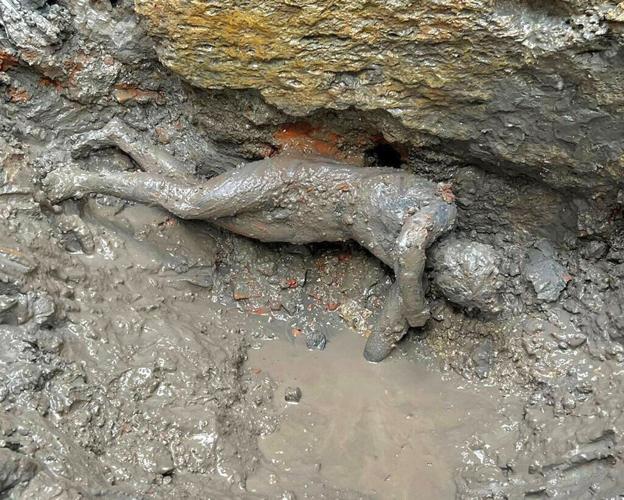I've came across an article in french, with a list of prodigies/portents recorded during first century BC. It gives a good idea of the strangeness of some events of these times, for context.
Source
Here's an excerpt's googletraduction :
"Magic and sorcery in Rome in the last century of the Republic [article]"
"We wish to show here that the last century of the Republic was a decisive period for the evolution of magic in Rome, marked both by a notable revival of interest in the practices of magicians and sorcerers and by the development of a new magic, more attractive for the cultured and social circles of the capital. It is precisely the success of this black science, new or at least renewed, which will better explain the anxious skepticism of Cicero, the attacks of the poets, the condemnation and the repression of Augustus."
"Whereas, as A. Alföldi 5 has clearly shown, the power of attraction of mantics tends to diminish from Marius and Sylla, not without however retaining the favor of the masses, where the new ideas about the world and the fate of man, the only ones capable of undermining old beliefs in dark forces, in the powers of the stars, in omens, these must have contributed to impressing a preoccupied, weary and soon horrified by civil wars. Not since the time of the Second Punic War,
so fertile in prodigia,
has Rome known as much as in the 1st BC. J.-C, all exploited, of course, the prodigy having become a "weapon of choice in political struggles" . R. Bloch, who studied them very well, mentioned several of them, as examples.
By completing his list, but without claiming to make it exhaustive, we see the following cases reported:
- In 90, during Sylla's military campaign in Italy, a flame rises from the half-open earth (Plut., Sylla, VI, 9). - A little later, a laurel wreath, a symbol of victory, appears on the liver of a victim he is in the process of sacrificing (Ibid., XXVII, 16).
- In 88, under the consulate of Sylla, a trumpet blast resounded in a serene sky (Ibid., VII) .
- In 87, under the consulship of Cn. Octavius, a comet appears (Cicero, De nat. deor., II, 5, 14); it is the year of comet Halley. It is also the year of the fulmination of Pompeius Strabo. We hear the sound of arms clashing in the sky; chasms open in the earth, from which spring flames, etc. The head of the statue of Apollo falls to the ground and attaches itself to it (him. Obs., 56 ss. [116]; Appian, B.c., I, 325 ss.) .
- On July 6, 83, during the dictatorship of Sylla, the collection of Sibylline Books burned in the fire of the Capitol. The eagerness to reconstruct it (which was done in 76) proves the interest that many attached to it; the number of its "guardians" - the decemuiri sacris faciundis - was on this occasion increased to fifteen (Den. Hal., IV, 62, 6). The same year, between Capua and Volturne, we hear a clash of arms and standards, accompanied by a frightful clamor (him. Obs., 57 [118]). From 65, we expect a "kosmische Zeitwende" (cosmic turning point) . Through the intermediary of the muse Uranie, are enumerated and described the celestial phenomena (comets, bolides) and terrestrial (nocturnal appearances of spectra), heralding the serious events of 63 (De consulatu suo, in Cic, De diuin., I, 17, 11 ss.; him. Obs., 61 [122]).
- In 57, a column of Jupiter on Mount Albain was struck by lightning (Cass. Dio, XXXIX, 3).
- In 56, a subterranean rumbling is heard in the Ager latiniensis (Cic, De harusp. resp., 20 ss.).
- At the end of 50, a graue ostentum is announced on the Cuman territory (a tree with too few branches), which according to the Sibylline Books means an approaching carnage (Pliny, H.N., XVII, 243); and
- on January 12, 49, during the passage of the Rubicon, a man of extraordinary size and beauty appeared (Suét, Diu. lui, 32).
- In 48, the year of Pharsalus, the celestial phenomena multiply: superic minaces prodigiis terras implerunt, aethera, pontum: comet, lightning in a serene sky, lightning on the "latial summit" (stars in broad daylight, disruption of the solar and lunar system, eruption of the iïtna, conflagration of the Alban altar of Vesta, etc., Lucain described with complaisance these "sure pledges of a worse destiny" (Phars., I, 524 ss.; him. Obs., 65 125).
- In 44, numerous wonders accompanied the death of Caesar: trumpets and the sound of arms in the sky, the sun was deprived of its light, the statues of the gods wept, oxen spoke (Tib., II, 5, 71 ss; him. Obs., 68 [128]). And especially in July 44, during Caesar's Victory Games, between the 20th and 30th, it was the appearance in the sky of Rome of the famous comet - the sidus Iulium - from which Octave-Augustus knew how to draw all the a party that is known to support with astral beliefs the apotheosis of the deceased imperator and the foundation of the imperial cult.
- In 43, a "bolide" appears during the battle of Modena (Pliny, H.N., II, 96). But it is the foundation of the second Triumvirate and its first decisions which are accompanied above all by frightening signs: wolves are seen on the Forum, oxen are talking, statues are crying, the sound of arms and horse races are perceived; the sun looks strange; lightning falls on temples and statues (Appian, Ce, IV, 4, 14; him. Obs., 69 [129]).
- In 42, the year of Philippi, new prodigies are reported: three suns are seen; the statue of Jupiter on Mount Alban oozes, etc. (him. Obs., 70 [130]).
After which the Liber prodigiorum remains silent until 17/16 to then mention the appearance of a comet. Whether Cicero, Pliny, and others who reported these wonders showed some skepticism about their interpretation as "astrological signs," matters little."
SNIP.




